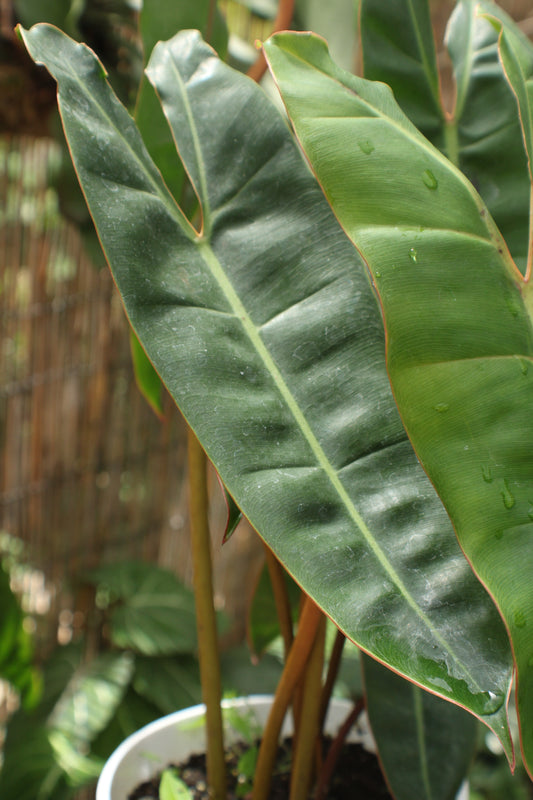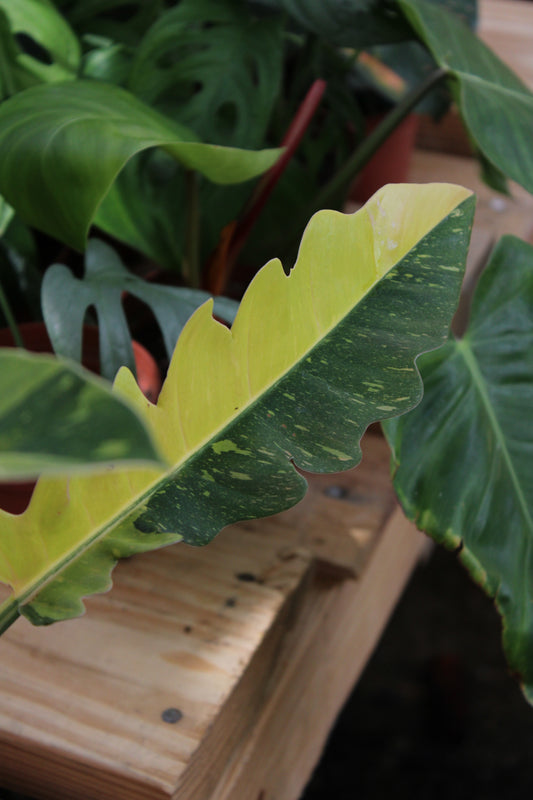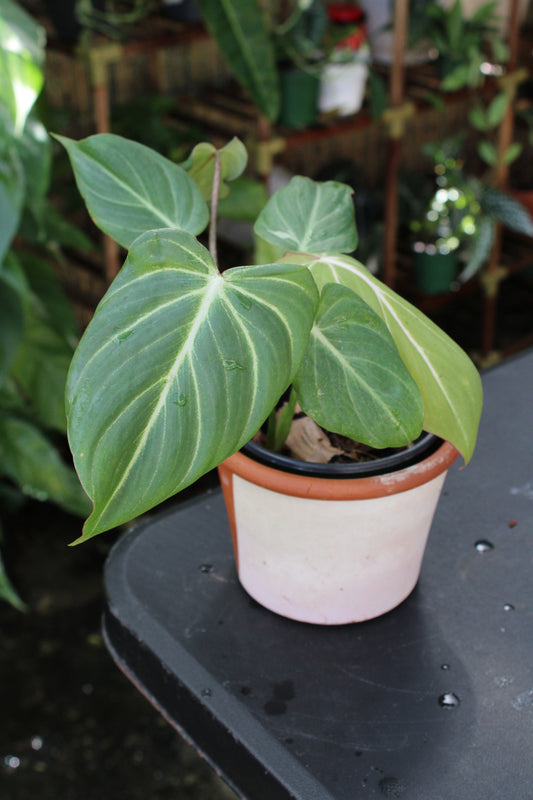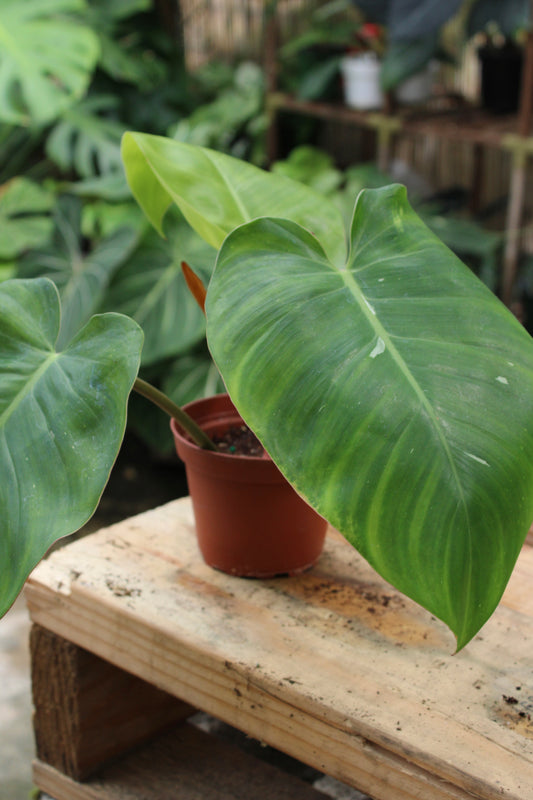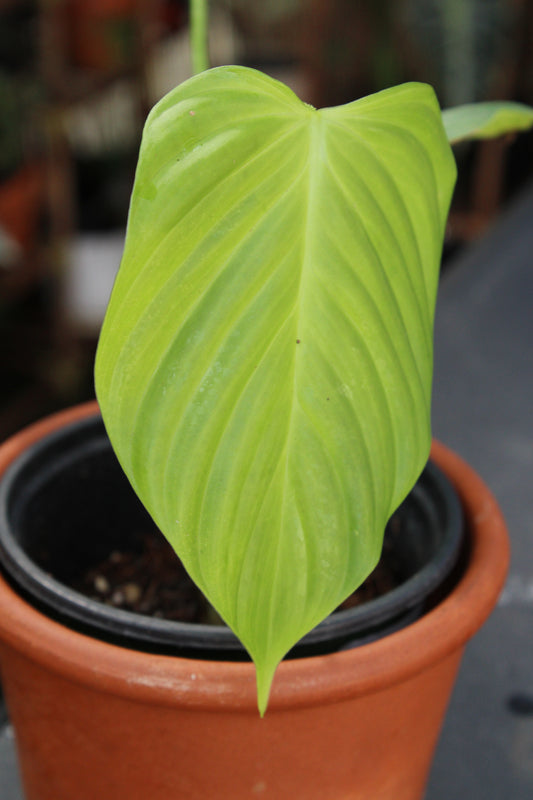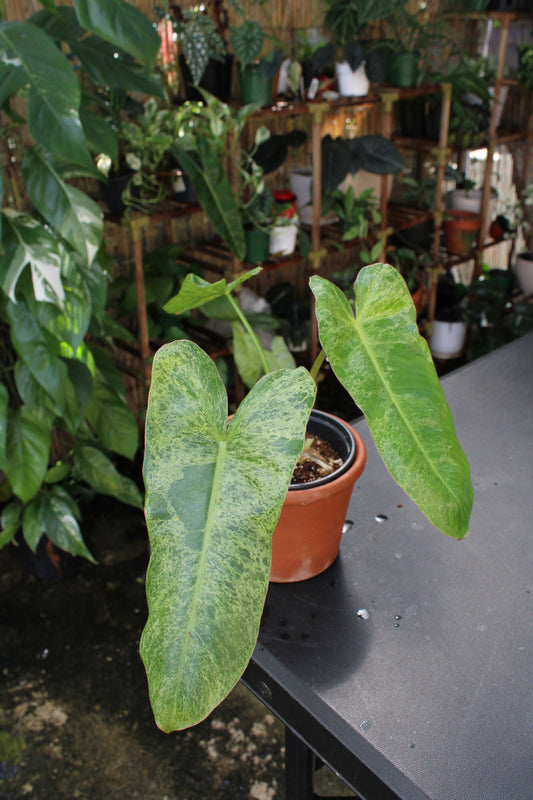
Philodendron Care
Philodendrons are a diverse group of tropical plants known for their attractive foliage and adaptability to indoor conditions.
Collapsible content

Billietiae Philodendron
LIGHT
The Billietiae Philodendron prefers bright indirect light, but will tolerate medium to low light. As light increases it creates more leaves. It can tolerate small periods direct sunlight, extended periods will burn the leaves.
WATER
It needs water when the soil is completely dry. Overwatering causes root rot, yellow leaves.
HUMIDITY
Philodendrons do well in low humidity, but high humidity between 70% and 90% will make the plant thrive and grow. It will benefit an additional misting.
TEMPERATURE
Your Philodendron prefers temperatures between 65-80 degrees.
FOOD
Philodendrons like to be fed monthly or every other month with some general indoor plant fertilizer.
TOXICITY
Philodendrons are toxic to pets and humans.
Additional Tips*
This plant will benefit from a moss support or a coconut fiber support. Any type of support that can contribute to its growth pattern will help this plant reach maturity.
Use a well-draining substrate, such as a mixture of coconut fiber, perlite, pine bark, and activated charcoal. This ensures good aeration and prevents excess humidity.
Birkin Philodendron
LIGHT
The Birkin Philodendron prefers bright indirect light, but will tolerate medium to low light. As light increases so will its variegation, it also creates more leaves. It cannot tolerate direct sunlight, it will cause the foliage to burn.
WATER
It needs water when its 50-75% dry or when the soil is completely dry. Too much water will lead to death. Overwatering causes root rot, yellow leaves. Adjust watering frequency in low light conditions.
HUMIDITY
This Philodendrons does well in low humidity, but high humidity between 65% and 80% will make the plant thrive and grow. It will benefit an additional misting.
TEMPERATURE
Your Philodendron prefers temperatures between 70-80 degrees.
FOOD
Philodendron like to be fed monthly or every other month with some general indoor plant fertilizer.
TOXICITY
Philodendrons are toxic to pets and humans.
Additional Tips*
This plant will benefit from a moss support or a coconut fiber support. Any type of support that can contribute to its growth pattern will help this plant reach maturity.
Use a well-draining substrate, such as a mixture of coconut fiber, perlite, pine bark, and activated charcoal. This ensures good aeration and prevents excess humidity.
Brasil Philodendron
LIGHT
The Brasil Philodendron prefers bright indirect light, but will tolerate medium to low light. As light increases so will its variegation, it also creates more leaves. It cannot tolerate direct sunlight, it will cause the foliage to burn.
WATER
It needs water when its 50-75% dry or when the soil is completely dry. Too much water will lead to death. Overwatering causes root rot, yellow leaves. Adjust watering frequency in low light conditions.
HUMIDITY
This Philodendrons does well in low humidity, but high humidity between 65% and 80% will make the plant thrive and grow. It will benefit an additional misting.
TEMPERATURE
Your Philodendron prefers temperatures between 70-80 degrees.
FOOD
Philodendron like to be fed monthly or every other month with some general indoor plant fertilizer.
TOXICITY
Philodendrons are toxic to pets and humans.
Additional Tips*
This plant will benefit from a moss support or a coconut fiber support. Any type of support that can contribute to its growth pattern will help this plant reach maturity.
Use a well-draining substrate, such as a mixture of coconut fiber, perlite, pine bark, and activated charcoal. This ensures good aeration and prevents excess humidity.
If you are looking for that bushy look, cut regularly since this plant sends out runners like crazy.
El Choco Red Philodendron
LIGHT
The El Choco Red Philodendron prefers bright indirect light. As the light increases, it creates more leaves. It will tolerate direct sunlight, for short periods; long periods will burn the foliage.
WATER
It needs water when it is between 50-75% dry or when the soil is completely dry. Too much water will cause death. Overwatering causes root rot and yellow leaves. Adjust watering frequency in low light conditions.
HUMIDITY
Philodendrons grow well in low humidity, but high humidity between 60%-80% will cause the plant to thrive and grow. It will benefit from additional misting.
TEMPERATURE
Your Philodendron prefers temperatures between 65-80 degrees.
FOOD
Philodendrons like to be fed monthly or every other month with some general houseplant fertilizer.
TOXICITY
Philodendrons are toxic to pets and humans. Digesting this plant will cause burning in the mouth, throat, lips, and tongue.
Additional Tips*
This plant will benefit from a moss support or a coconut fiber support. Any type of support that can contribute to its growth pattern will help this plant reach maturity.
Use a well-draining substrate, such as a mixture of coconut fiber, perlite, pine bark, and activated charcoal. This ensures good aeration and prevents excess humidity.
Esmeraldense Philodendron
LIGHT
The Philodendron Esmeraldense prefers bright indirect light. As the light increases, it creates more leaves. It will tolerate direct sunlight, for short periods; long periods will burn the foliage.
WATER
It needs water when it is 50-75% dry or when the soil is completely dry. Too much water will cause death. Overwatering causes root rot and yellow leaves. Adjust watering frequency in low light conditions.
HUMIDITY
Philodendrons grow well in low humidity, but high humidity between 60% and 80% will cause the plant to thrive and grow. It will benefit from additional misting.
TEMPERATURE
Your Philodendron prefers temperatures between 65 and 80 degrees.
FOOD
Philodendrons like to be fed monthly or every other month with some general houseplant fertilizer.
TOXICITY
Philodendrons are toxic to pets and humans. Digesting this plant will cause burning in the mouth, throat, lips and tongue.
Additional Tips*
This plant will benefit from a moss support or a coconut fiber support. Any type of support that can contribute to its growth pattern will help this plant reach maturity.
Use a well-draining substrate, such as a mixture of coconut fiber, perlite, pine bark, and activated charcoal. This ensures good aeration and prevents excess humidity.
Fuzzy Petiole Philodendron
LIGHT
The Fuzzy Petiole Philodendron prefers bright indirect light, As light increases, it creates more leaves. It tolerates direct sunlight, for short periods, long periods will burn the foliage.
WATER
It needs water when its 50-75% dry or when the soil is completely dry. Too much water will lead to death. Overwatering causes root rot, yellow leaves. Adjust watering frequency in low light conditions.
HUMIDITY
Philodendrons do well in low humidity, but high humidity between 60% and 80% will make the plant thrive and grow. It will benefit an additional misting.
TEMPERATURE
Your Philodendron prefers temperatures between 65-80 degrees.
FOOD
Philodendrons like to be fed monthly or every other month with some general indoor plant fertilizer.
TOXICITY
Philodendrons are toxic to pets and humans. Digesting this plant will cause burning in mouth throat, lips and tongue.
Additional Tips*
This plant will benefit from a moss support or a coconut fiber support. Any type of support that can contribute to its growth pattern will help this plant reach maturity.
Use a well-draining substrate, such as a mixture of coconut fiber, perlite, pine bark, and activated charcoal. This ensures good aeration and prevents excess humidity.
Florida Green Philodendron
LIGHT
The Florida Green Philodendron prefers bright indirect light, but will tolerate medium to low light. It can tolerate short periods of direct sunlight; extended periods will burn the leaves.
WATER
It needs water when it is at 50% or when the soil is completely dry. Overwatering causes root rot and yellow leaves.
HUMIDITY
Philodendrons grow well in low humidity, but high humidity between 60% and 80% will cause the plant to thrive and grow. It will benefit from an additional mist for larger leaves.
TEMPERATURE
Your Philodendrons prefer temperatures between 65 and 75 degrees.
FOOD
Philodendrons like to be fed monthly or bi-monthly with a general houseplant fertilizer.
TOXICITY
Philodendrons are toxic to pets and humans.
Additional Tips*
This plant will benefit from a moss support or a coconut fiber support. Any type of support that can contribute to its growth pattern will help this plant reach maturity.
Use a well-draining substrate, such as a mixture of coconut fiber, perlite, pine bark, and activated charcoal. This ensures good aeration and prevents excess humidity.
Gloriosum Philodendron
LIGHT
The Gloriosum Philodendron prefers bright indirect light. It cannot tolerate direct sunlight, it will cause the foliage to burn.
WATER
It needs water when its 50-75% dry or when the soil is completely dry. Too much water will lead to death. Overwatering causes root rot, yellow leaves. Adjust watering frequency in low light conditions.
HUMIDITY
Philodendrons do well in low humidity, but high humidity between 60% and 80% will make the plant thrive and grow. It will benefit an additional misting.
TEMPERATURE
Your Philodendron prefers temperatures between 65-85 degrees.
FOOD
Philodendrons like to be fed monthly or every other month with some general indoor plant fertilizer.
TOXICITY
Philodendrons are toxic to pets and humans. Digesting this plant will cause burning in mouth throat, lips and tongue.
Additional Tips*
As a creeping plant, it will reach maturity in a horizontal pot.
Use a well-draining substrate, such as a mixture of coconut fiber, perlite, pine bark, and activated charcoal. This ensures good aeration and prevents excess humidity.
Golden Goddess Philodendron
LIGHT
The Golden Goddess Philodendron prefers bright indirect light, but will tolerate medium to low light. As light increases so will its coloration, it also creates more leaves. It can tolerate some morning sunlight, long extended periods will cause the foliage to burn
WATER
It needs water when its 50-75% dry or when the soil is completely dry. Too much water will lead to death. Overwatering causes root rot, yellow leaves. Adjust watering frequency in low light conditions.
HUMIDITY
This Philodendrons does well in low humidity, but high humidity between 65% and 80% will make the plant thrive and grow. It will benefit an additional misting.
TEMPERATURE
Your Philodendron prefers temperatures between 70-80 degrees.
FOOD
Philodendron like to be fed monthly or every other month with some general indoor plant fertilizer.
TOXICITY
Philodendrons are toxic to pets and humans. Digesting this plant will cause burning in mouth throat, lips and tongue.
Additional Tips*
This plant will benefit from a moss support or a coconut fiber support. Any type of support that can contribute to its growth pattern will help this plant reach maturity.
Use a well-draining substrate, such as a mixture of coconut fiber, perlite, pine bark, and activated charcoal. This ensures good aeration and prevents excess humidity.
Majestic Philodendron
LIGHT
The Majestic Philodendron prefers bright indirect light. As the light increases, it creates more leaves. It will tolerate direct sunlight, for short periods; long periods will burn the foliage.
WATER
It needs water when it is between 50-75% dry or when the soil is completely dry. Too much water will cause death. Overwatering causes root rot and yellow leaves. Adjust watering frequency in low light conditions.
HUMIDITY
Philodendrons grow well in low humidity, but high humidity between 60%-80% will cause the plant to thrive and grow. It will benefit from additional misting.
TEMPERATURE
Your Philodendron prefers temperatures between 65-80 degrees.
FOOD
Philodendrons like to be fed monthly or every other month with some general houseplant fertilizer.
TOXICITY
Philodendrons are toxic to pets and humans. Digesting this plant will cause burning in the mouth, throat, lips, and tongue.
Additional Tips*
This plant will benefit from a moss support or a coconut fiber support. Any type of support that can contribute to its growth pattern will help this plant reach maturity.
Use a well-draining substrate, such as a mixture of coconut fiber, perlite, pine bark, and activated charcoal. This ensures good aeration and prevents excess humidity.
Melanochrysum Philodendron
LIGHT
The Philodendron Melano prefers bright indirect light. As the light increases, it creates more leaves. It will tolerate direct sunlight, for short periods; long periods will burn the foliage.
WATER
It needs water when it is 50-75% dry or when the soil is completely dry. Too much water will cause death. Overwatering causes root rot and yellow leaves. Adjust watering frequency in low light conditions.
HUMIDITY
Philodendrons grow well in low humidity, but high humidity between 60% and 80% will cause the plant to thrive and grow. It will benefit from additional misting.
TEMPERATURE
Your Philodendron prefers temperatures between 65 and 80 degrees.
FOOD
Philodendrons like to be fed monthly or every other month with some general houseplant fertilizer.
TOXICITY
Philodendrons are toxic to pets and humans. Digesting this plant will cause burning in the mouth, throat, lips and tongue.
Additional Tips*
This plant will benefit from a moss support or a coconut fiber support. Any type of support that can contribute to its growth pattern will help this plant reach maturity.
Use a well-draining substrate, such as a mixture of coconut fiber, perlite, pine bark, and activated charcoal. This ensures good aeration and prevents excess humidity.
Glorious Philodendron
LIGHT
The Philodendron Glorious prefers bright indirect light. As the light increases, it creates more leaves. It will tolerate direct sunlight, for short periods; long periods will burn the foliage.
WATER
It needs water when it is 50-75% dry or when the soil is completely dry. Too much water will cause death. Overwatering causes root rot and yellow leaves. Adjust watering frequency in low light conditions.
HUMIDITY
Philodendrons grow well in low humidity, but high humidity between 60% and 80% will cause the plant to thrive and grow. It will benefit from additional misting.
TEMPERATURE
Your Philodendron prefers temperatures between 65 and 80 degrees.
FOOD
Philodendrons like to be fed monthly or every other month with some general houseplant fertilizer.
TOXICITY
Philodendrons are toxic to pets and humans. Digesting this plant will cause burning in the mouth, throat, lips and tongue.
Additional Tips*
This plant will benefit from a moss support or a coconut fiber support. Any type of support that can contribute to its growth pattern will help this plant reach maturity.
Use a well-draining substrate, such as a mixture of coconut fiber, perlite, pine bark, and activated charcoal. This ensures good aeration and prevents excess humidity.
Paraiso Verde Philodendron
LIGHT
The Paraiso Verde Philodendron prefers bright indirect light, but will tolerate medium to low light. It can tolerate small periods direct sunlight, extended periods will burn the leaves.
WATER
It needs water when the soil is completely dry. Overwatering causes root rot, yellow leaves.
HUMIDITY
It generally needs above average humidity like 60-80% but will do fine in household humidity.
TEMPERATURE
Your Philodendron prefers temperatures between 65-80 degrees. As temperature rises it will produce more variegation
FOOD
Philodendrons like to be fed monthly or every other month with some general indoor plant fertilizer.
TOXICITY
It's toxic to pets and humans. Digesting it will cause stomach pain and vomiting.
Additional Tips*
This plant will benefit from a moss support or a coconut fiber support. Any type of support that can contribute to its growth pattern will help this plant reach maturity.
Use a well-draining substrate, such as a mixture of coconut fiber, perlite, pine bark, and activated charcoal. This ensures good aeration and prevents excess humidity.
Pink Congo Philodendron
LIGHT
The Pink Congo Philodendron prefers bright indirect light, but will tolerate medium to low light. As light increases so will its coloration. It can tolerate small periods direct sunlight, extended periods will burn the leaves.
WATER
It needs water when its 50% or when the soil is completely dry. Overwatering causes root rot, yellow leaves.
HUMIDITY
Philodendrons do well in low humidity, but high humidity between 50% and 60% will make the plant thrive and grow. It will benefit an additional misting for bigger leaves.
TEMPERATURE
Your Philodendron prefers temperatures between 65-80 degrees.
FOOD
Philodendrons like to be fed monthly or every other month with some general indoor plant fertilizer.
TOXICITY
Philodendrons are toxic to pets and humans.
Additional Tips*
This plant will benefit from a moss support or a coconut fiber support. Any type of support that can contribute to its growth pattern will help this plant reach maturity.
Use a well-draining substrate, such as a mixture of coconut fiber, perlite, pine bark, and activated charcoal. This ensures good aeration and prevents excess humidity.
Pink Glory Philodendron
LIGHT
The Pink Glory Philodendron prefers bright indirect light. It cannot tolerate direct sunlight, it will cause the foliage to burn.
WATER
It needs water when its 50-75% dry or when the soil is completely dry. Too much water will lead to death. Overwatering causes root rot, yellow leaves. Adjust watering frequency in low light conditions.
HUMIDITY
Philodendrons do well in low humidity, but high humidity between 60% and 80% will make the plant thrive and grow. It will benefit an additional misting.
TEMPERATURE
Your Philodendron prefers temperatures between 65-85 degrees.
FOOD
Philodendrons like to be fed monthly or every other month with some general indoor plant fertilizer.
TOXICITY
Philodendrons are toxic to pets and humans. Digesting this plant will cause burning in mouth throat, lips and tongue.
Additional Tips*
As a creeping plant, it will reach maturity in a horizontal pot.
Use a well-draining substrate, such as a mixture of coconut fiber, perlite, pine bark, and activated charcoal. This ensures good aeration and prevents excess humidity.
Plowmanii Philodendron
LIGHT
The Plowmanii Philodendron prefers bright indirect light, but will tolerate medium to low light. It can tolerate small periods direct sunlight, extended periods will burn the leaves.
WATER
It needs water when its 50% or when the soil is completely dry. Overwatering causes root rot, yellow leaves.
HUMIDITY
Philodendrons do well in low humidity, but high humidity between 50% and 60% will make the plant thrive and grow. It will benefit an additional misting for bigger leaves.
TEMPERATURE
Your Philodendron prefers temperatures between 65-80 degrees.
FOOD
Philodendrons like to be fed monthly or every other month with some general indoor plant fertilizer.
TOXICITY
Philodendrons are toxic to pets and humans.
Additional Tips*
As a creeping plant, it will reach maturity in a horizontal pot.
Use a well-draining substrate, such as a mixture of coconut fiber, perlite, pine bark, and activated charcoal. This ensures good aeration and prevents excess humidity.
Ring of Fire Philodendron
LIGHT
The Ring of Fire Philodendron prefers bright indirect light, but will tolerate medium to low light. As light increases so will its variegation, it also creates more leaves. It does not tolerate direct sunlight, it will burn the leaves.
WATER
It needs water when its 50% dry or when the soil is completely dry. Too much water will lead to death. Overwatering causes root rot, yellow leaves. Adjust watering frequency in low light conditions
HUMIDITY
Philodendrons do well in low humidity, but high humidity between 30% and 60% will make the plant thrive and grow. It will benefit an additional misting.
TEMPERATURE
Your Philodendron prefers temperatures between 55-80 degrees.
FOOD
Philodendrons like to be fed monthly or every other month with some general indoor plant fertilizer.
TOXICITY
Philodendrons are toxic to pets and humans.
Additional Tips*
This plant will benefit from a moss support or a coconut fiber support. Any type of support that can contribute to its growth pattern will help this plant reach maturity.
Use a well-draining substrate, such as a mixture of coconut fiber, perlite, pine bark, and activated charcoal. This ensures good aeration and prevents excess humidity.
Sharoniae Philodendron
LIGHT
The Philodendron Sharoniae prefers bright indirect light. As the light increases, it creates more leaves. It will tolerate direct sunlight, for short periods; long periods will burn the foliage.
WATER
It needs water when it is 50-75% dry or when the soil is completely dry. Too much water will cause death. Overwatering causes root rot and yellow leaves. Adjust watering frequency in low light conditions.
HUMIDITY
Philodendrons grow well in low humidity, but high humidity between 60% and 80% will cause the plant to thrive and grow. It will benefit from additional misting.
TEMPERATURE
Your Philodendron prefers temperatures between 65 and 80 degrees.
FOOD
Philodendrons like to be fed monthly or every other month with some general houseplant fertilizer.
TOXICITY
Philodendrons are toxic to pets and humans. Digesting this plant will cause burning in the mouth, throat, lips and tongue.
Additional Tips*
This plant will benefit from a moss support or a coconut fiber support. Any type of support that can contribute to its growth pattern will help this plant reach maturity.
Use a well-draining substrate, such as a mixture of coconut fiber, perlite, pine bark, and activated charcoal. This ensures good aeration and prevents excess humidity.
Silver Sword Philodendron
LIGHT
The Silver Sword Philodendron prefers bright indirect light. It does not tolerate direct sunlight as it will burn the foliage.
WATER
It needs water when it is 50-75% dry or when the soil is completely dry. Too much water will cause death. Overwatering causes root rot and yellow leaves. Adjust watering frequency in low light conditions.
HUMIDITY
Philodendrons grow well in low humidity, but high humidity between 60% and 80% will cause the plant to thrive and grow. It will benefit from additional misting.
TEMPERATURE
Your Philodendrons prefer temperatures between 65 and 85 degrees.
FOOD
Philodendrons like to be fed monthly or every other month with some general houseplant fertilizer.
TOXICITY
Philodendrons are toxic to pets and humans. Digesting this plant will cause burning in the mouth, throat, lips and tongue.
Additional Tips*
This plant will benefit from a moss support or a coconut fiber support. Any type of support that can contribute to its growth pattern will help this plant reach maturity.
Use a well-draining substrate, such as a mixture of coconut fiber, perlite, pine bark, and activated charcoal. This ensures good aeration and prevents excess humidity.
Splendid Philodendron
LIGHT
The Splendid Philodendron prefers bright indirect light. It does not tolerate direct sunlight as it will burn the foliage.
WATER
It needs water when it is 50-75% dry or when the soil is completely dry. Too much water will cause death. Overwatering causes root rot and yellow leaves. Adjust watering frequency in low light conditions.
HUMIDITY
Philodendrons grow well in low humidity, but high humidity between 60% and 80% will cause the plant to thrive and grow. It will benefit from additional misting.
TEMPERATURE
Your Philodendrons prefer temperatures between 65 and 85 degrees.
FOOD
Philodendrons like to be fed monthly or every other month with some general houseplant fertilizer.
TOXICITY
Philodendrons are toxic to pets and humans. Digesting this plant will cause burning in the mouth, throat, lips and tongue.
Additional Tips*
This plant will benefit from a moss support or a coconut fiber support. Any type of support that can contribute to its growth pattern will help this plant reach maturity.
Use a well-draining substrate, such as a mixture of coconut fiber, perlite, pine bark, and activated charcoal. This ensures good aeration and prevents excess humidity.
Tree Philodendron
LIGHT
The Philodendron Tree prefers bright indirect light. As the light increases, it creates more leaves. It will tolerate direct sunlight, for short periods; long periods will burn the foliage.
WATER
It needs water when it is 50-75% dry or when the soil is completely dry. Too much water will cause death. Overwatering causes root rot and yellow leaves. Adjust watering frequency in low light conditions.
HUMIDITY
Philodendrons grow well in low humidity, but high humidity between 60% and 80% will cause the plant to thrive and grow. It will benefit from additional misting.
TEMPERATURE
Your Philodendron prefers temperatures between 65 and 80 degrees.
FOOD
Philodendrons like to be fed monthly or every other month with some general houseplant fertilizer.
TOXICITY
Philodendrons are toxic to pets and humans. Digesting this plant will cause burning in the mouth, throat, lips and tongue.
Additional Tips*
This plant will benefit from a moss support or a coconut fiber support. Any type of support that can contribute to its growth pattern will help this plant reach maturity.
Use a well-draining substrate, such as a mixture of coconut fiber, perlite, pine bark, and activated charcoal. This ensures good aeration and prevents excess humidity.
When this plant reaches maturity it tends to fenestrate.
Verrucosum Philodendron
LIGHT
The Verrucosum Philodendron prefers bright indirect light. It cannot tolerate direct sunlight, it will cause the foliage to burn. Too little light will cause slow growth
WATER
It needs water when the soil is completely dry.
HUMIDITY
Philodendrons do well in low humidity, but high humidity over 70% will make the plant thrive and grow. It will benefit an additional misting.
TEMPERATURE
Your Philodendron prefers temperatures between 65-80 degrees.
FOOD
Philodendrons like to be fed monthly or every other month with some general indoor plant fertilizer.
TOXICITY
Philodendrons are toxic to pets and humans. Digesting this plant will cause burning in mouth throat, lips and tongue.
Additional Tips*
This plant will benefit from a moss support or a coconut fiber support. Any type of support that can contribute to its growth pattern will help this plant reach maturity.
Use a well-draining substrate, such as a mixture of coconut fiber, perlite, pine bark, and activated charcoal. This ensures good aeration and prevents excess humidity.
White Knight Philodendron
LIGHT
The White Knight Philodendron prefers bright indirect light, but will tolerate medium to low light. As light increases so will its variegation It can tolerate small periods direct sunlight, extended periods will burn the leaves.
WATER
It needs water when its 50% or when the soil is completely dry. Overwatering causes root rot, yellow leaves.
HUMIDITY
Philodendrons do well in low humidity, but high humidity between 60% and 80% will make the plant thrive and grow. It will benefit an additional misting for bigger leaves.
TEMPERATURE
Your Philodendron prefers temperatures between 65-75 degrees.
FOOD
Philodendrons like to be fed monthly or every other month with some general indoor plant fertilizer.
TOXICITY
Philodendrons are toxic to pets and humans.
Additional Tips*
This plant will benefit from a moss support or a coconut fiber support. Any type of support that can contribute to its growth pattern will help this plant reach maturity.
Use a well-draining substrate, such as a mixture of coconut fiber, perlite, pine bark, and activated charcoal. This ensures good aeration and prevents excess humidity.
White Princess Philodendron
LIGHT
The White Princess Philodendron prefers bright indirect light, but will tolerate medium to low light. As light increases so will its variegation It can tolerate small periods direct sunlight, extended periods will burn the leaves.
WATER
It needs water when its 50% or when the soil is completely dry. Overwatering causes root rot, yellow leaves.
HUMIDITY
Philodendrons do well in low humidity, but high humidity between 60% and 80% will make the plant thrive and grow. It will benefit an additional misting for bigger leaves.
TEMPERATURE
Your Philodendron prefers temperatures between 65-75 degrees.
FOOD
Philodendrons like to be fed monthly or every other month with some general indoor plant fertilizer.
TOXICITY
Philodendrons are toxic to pets and humans.
Additional Tips*
This plant will benefit from a moss support or a coconut fiber support. Any type of support that can contribute to its growth pattern will help this plant reach maturity.
Use a well-draining substrate, such as a mixture of coconut fiber, perlite, pine bark, and activated charcoal. This ensures good aeration and prevents excess humidity.
White Wizard Philodendron
LIGHT
The White Wizard Philodendron prefers bright indirect light, but will tolerate medium to low light. As light increases so will its variegation It can tolerate small periods direct sunlight, extended periods will burn the leaves.
WATER
It needs water when its 50% or when the soil is completely dry. Overwatering causes root rot, yellow leaves.
HUMIDITY
Philodendrons do well in low humidity, but high humidity between 60% and 80% will make the plant thrive and grow. It will benefit an additional misting for bigger leaves.
TEMPERATURE
Your Philodendron prefers temperatures between 65-75 degrees.
FOOD
Philodendrons like to be fed monthly or every other month with some general indoor plant fertilizer.
TOXICITY
Philodendrons are toxic to pets and humans.
Additional Tips*
This plant will benefit from a moss support or a coconut fiber support. Any type of support that can contribute to its growth pattern will help this plant reach maturity.
Use a well-draining substrate, such as a mixture of coconut fiber, perlite, pine bark, and activated charcoal. This ensures good aeration and prevents excess humidity.


